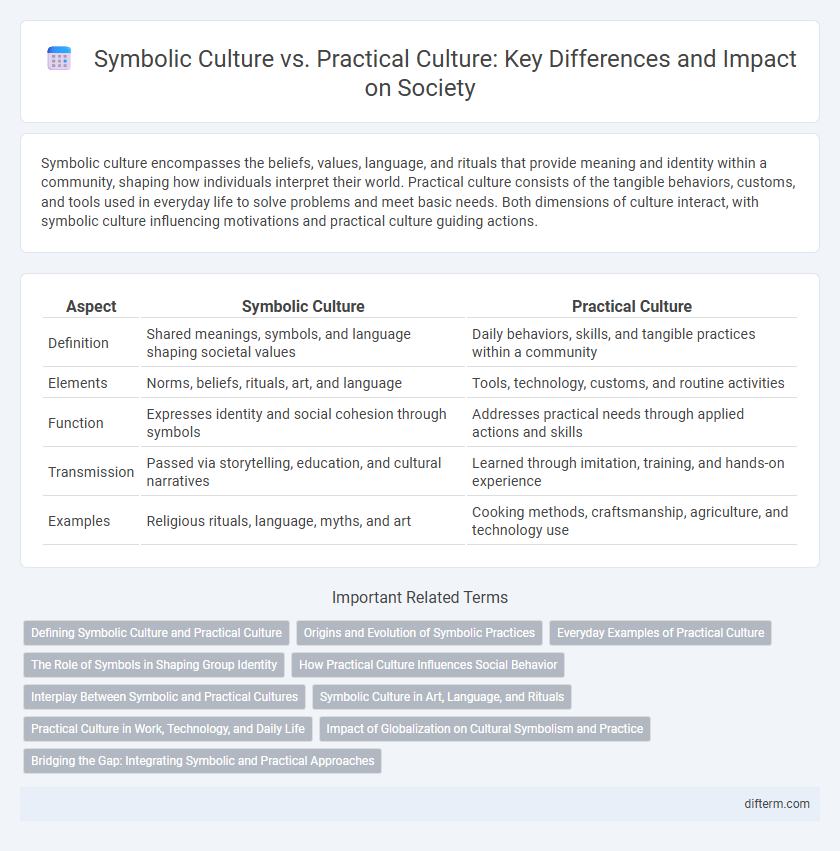Symbolic culture encompasses the beliefs, values, language, and rituals that provide meaning and identity within a community, shaping how individuals interpret their world. Practical culture consists of the tangible behaviors, customs, and tools used in everyday life to solve problems and meet basic needs. Both dimensions of culture interact, with symbolic culture influencing motivations and practical culture guiding actions.
Table of Comparison
| Aspect | Symbolic Culture | Practical Culture |
|---|---|---|
| Definition | Shared meanings, symbols, and language shaping societal values | Daily behaviors, skills, and tangible practices within a community |
| Elements | Norms, beliefs, rituals, art, and language | Tools, technology, customs, and routine activities |
| Function | Expresses identity and social cohesion through symbols | Addresses practical needs through applied actions and skills |
| Transmission | Passed via storytelling, education, and cultural narratives | Learned through imitation, training, and hands-on experience |
| Examples | Religious rituals, language, myths, and art | Cooking methods, craftsmanship, agriculture, and technology use |
Defining Symbolic Culture and Practical Culture
Symbolic culture encompasses the intangible aspects of culture, including language, beliefs, values, norms, and symbols that convey meaning and identity within a society. Practical culture refers to the tangible, everyday behaviors, rituals, tools, and technologies that individuals use to navigate and adapt to their environment. Understanding the distinction between symbolic culture and practical culture highlights how societies transmit both abstract ideas and concrete practices across generations.
Origins and Evolution of Symbolic Practices
Symbolic culture originates from the human capacity for abstract thought and communication, evolving as societies developed complex languages, rituals, and belief systems to convey meaning beyond practical needs. Early symbolic practices emerged in prehistoric times with cave paintings, religious ceremonies, and the creation of iconic artifacts that encoded shared values and identities. Over millennia, symbolic culture has expanded through art, literature, and digital media, reflecting shifting ideologies and strengthening social cohesion.
Everyday Examples of Practical Culture
Practical culture encompasses everyday activities and behaviors that fulfill basic needs, such as cooking traditional meals, using tools for farming, or practicing hygiene routines. These actions demonstrate how practical culture directly influences daily survival and social organization through hands-on skills and material practices. Unlike symbolic culture, which centers on meaning and values, practical culture is evident in routine tasks like clothing choices suited to climate or construction methods adapted to local resources.
The Role of Symbols in Shaping Group Identity
Symbols serve as powerful tools in shaping group identity by embedding shared meanings and values within a culture, distinguishing symbolic culture from practical culture focused on material and utilitarian aspects. Symbolic culture, through language, rituals, and artistic expressions, conveys collective beliefs that foster social cohesion and continuity across generations. Practical culture, while necessary for daily survival and technological advancement, lacks the emotive and ideological significance that symbols provide in uniting members under a common identity.
How Practical Culture Influences Social Behavior
Practical culture shapes social behavior by establishing daily routines, customs, and norms that guide individuals' interactions and decision-making processes within a community. It includes tangible practices such as dress codes, culinary traditions, and work ethics that directly affect how people cooperate, communicate, and solve problems. This cultural framework promotes social cohesion and stability by reinforcing predictable and efficient behaviors aligned with shared practical needs.
Interplay Between Symbolic and Practical Cultures
Symbolic culture encompasses the intangible elements of culture such as beliefs, values, language, and rituals, which provide meaning and identity within societies. Practical culture involves the material aspects, including tools, technology, and everyday practices that sustain daily life. The interplay between symbolic and practical cultures shapes social behavior as symbolic meanings influence how practical tools are used, while practical experiences often transform and reinforce symbolic beliefs.
Symbolic Culture in Art, Language, and Rituals
Symbolic culture manifests through art, language, and rituals by conveying shared meanings and values that transcend practical functionality. Art serves as a visual language that expresses identity and collective memory, while language provides a system of symbols facilitating complex communication and cultural transmission. Rituals embody symbolic actions that reinforce social cohesion, marking significant cultural milestones and perpetuating tradition.
Practical Culture in Work, Technology, and Daily Life
Practical culture encompasses the tangible skills, tools, and routines that shape daily life, work, and technology use, emphasizing efficiency and functionality over abstract meaning. In workplaces, practical culture manifests through standardized procedures, technical expertise, and adaptable problem-solving methods that optimize productivity. Technological integration in daily routines reflects this culture by streamlining tasks, enhancing communication, and fostering innovation grounded in pragmatic utility.
Impact of Globalization on Cultural Symbolism and Practice
Globalization accelerates the exchange of symbolic culture, such as language, art, and rituals, leading to hybrid cultural identities and the diffusion of global symbols like brands and media icons. Practical culture, encompassing everyday customs and technology use, adapts rapidly as global communication, trade, and migration introduce new tools, behaviors, and social norms. This dynamic interaction reshapes cultural symbolism and practices, often creating tensions between preserving local traditions and embracing global influences.
Bridging the Gap: Integrating Symbolic and Practical Approaches
Bridging the gap between symbolic culture and practical culture involves integrating rituals, language, and shared beliefs with everyday actions and tangible technologies to create a cohesive social experience. Symbolic culture, encompassing values and meanings, shapes perceptions, while practical culture focuses on skills, tools, and behaviors necessary for survival and innovation. Successful cultural integration fosters community identity, enhances cooperation, and drives social progress through the harmonious interaction of symbolic significance and practical utility.
Symbolic culture vs Practical culture Infographic

 difterm.com
difterm.com